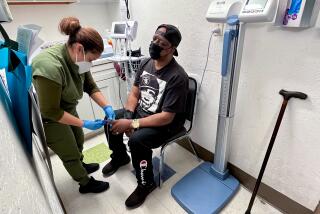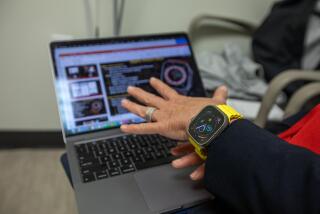Tests Replacing Doctors’ Ears, Eyes : Bedside Manner Mourned as Victim of Technology
- Share via
In the lowly stethoscope, the physician’s compass, may lie a curious allegory about modern medicine and modern life: How pricey precision instruments edge out efficient, economical tools, occasionally with little justification.
The role of the stethoscope in interpreting the murmurings of some human hearts has shrunk in recent years. Instead, doctors defer increasingly to high-tech tools that produce vivid images of abnormalities underlying unusual sounds.
But a new study has found that traditional “bedside maneuvers” can be highly accurate in diagnosing the causes of heart murmurs. Resuscitating those methods, some researchers now suggest, would be a small step toward controlling costs and humanizing medicine.
“With the advent of all the new technology, physicians aren’t that much interested (in bedside medicine),” said Dr. Nicholas Lembo, who led the study published today in The New England Journal of Medicine, “because they could order a $300 to $400 test to tell them something that they could have found by listening.”
“The present trend . . . may soon leave us with a whole new generation of young physicians who have no confidence in their own ability to make worthwhile bedside diagnoses,” states an editorial accompanying Lembo’s study in the journal.
Lembo and some others suggest that the problem of bias in favor of high-tech gadgetry is not confined to cardiology. Some believe it is endemic in the American system of medicine and is reinforced by insurers, educators, even patients.
Some patients expect tests and are miffed when they do not receive them. Some doctors use tests as a hedge against lawsuits, physicians said. And insurers often reimburse at a higher rate for tests than for painstaking physical examinations that might reach the same conclusion.
In the past cardiologists relied primarily on their ears and hands to identify the causes and severity of a heart murmur--a soft blowing or rasping sound caused by blood flowing through the heart and sometimes indicative of a heart disorder.
High-Tech Techniques
But over the last 20 years, several high-tech techniques have become available to image and examine the inside of the heart. They include echocardiography, which uses sound waves to image heart valves, and Doppler monitoring, which measures the velocity of blood flow.
According to Lembo and others, there has been a simultaneous decline in traditional cardiac examinations, which can include having the patient perform a series of simple physical exercises that help indicate to a physician listening through a stethoscope the severity and significance of a murmur.
“The echocardiogram-Doppler technique has been used almost as a stethoscope,” Lembo, a cardiologist at Emory University School of Medicine, said in a telephone interview. “When somebody hears a murmur, they don’t figure out what it is. They just order (the test).”
“It’s a frustration for me as a full-time physician trying to train cardiology fellows,” said Dr. Howard N. Allen, director of a cardiac laboratory at Cedars-Sinai Medical Center in Los Angeles who shares Lembo’s view that tests are overused.
“It’s the exception who is interested in how to examine a patient properly,” Allen said. “Most of them want to learn how to do procedures--how to do and interpret echocardiograms. They know that’s how they are better going to make a living.”
So Lembo’s group evaluated the accuracy of the traditional bedside maneuvers using 50 patients with heart murmurs that had already been documented by high-tech methods. They brought in two outside cardiologists who had no previous exposure to the patients.
While the patients went through combinations of maneuvers, the cardiologists were able not only to recognize the murmurs but to develop accurate diagnoses of their causes and severity based purely on the sounds coming through the stethoscope.
“What we’re saying is, on certain people, a majority, you don’t need more than the simple test,” said Lembo. However, he and others were careful to point out that echocardiography and other techniques play an important role in diagnosing more serious cases.
“They are obviously more objective and in many ways more precise,” said Dr. Ernest Craige, a professor emeritus at the University of North Carolina who wrote the editorial accompanying Lembo’s study.
‘Deserves a Place’
“So I don’t mean (using a stethoscope) can really compete with those techniques in that respect,” he said. “But that it deserves a place so that these expensive, high-tech procedures can be more cost-effective in their use.”
The consequences of a high-tech bias are more than economic, he and others said.
Even those machines occasionally make mistakes, they said. And young physicians may be being trained in techniques that may be inapplicable in other countries. Finally, some said, high technology has diminished the quality of communication between patient and physician.
“I think there is tremendous satisfaction in sitting down with a patient . . . and trying to determine what (if anything) is wrong on the basis of observations made solely through verbal communication and physical diagnosis,” Craige wrote in his editorial.
“In a day when many doctors advise their sons and daughters not to go into medicine because the joy has gone out of it, I would suggest that the rehabilitation of (stethoscope diagnosis) would supply a substantial dose of this vital ingredient.”
Craige was asked in an interview what he thought were the chances of this happening.
“Well, I think it’s about like trying to stop the SDI (Strategic Defense Initiative), don’t you?” he said.





